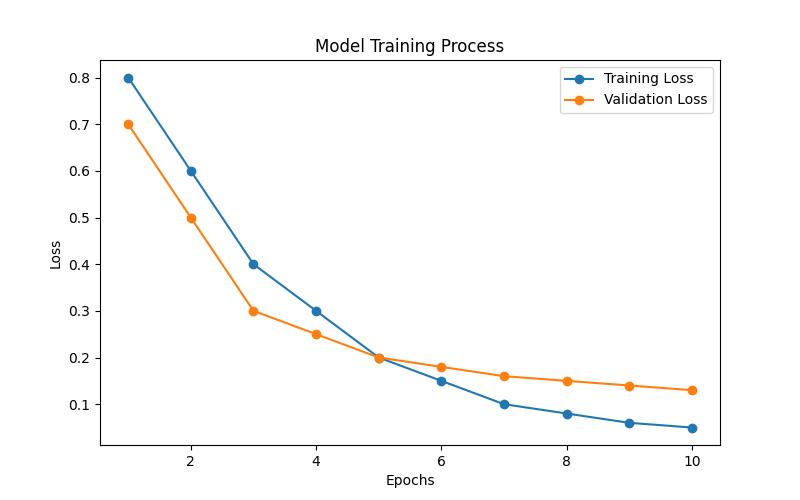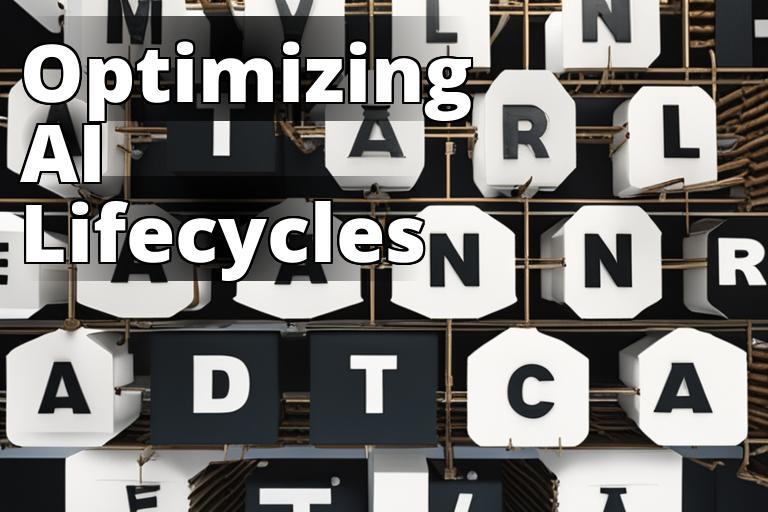Contents hide2 The Lifecycle Phases of AI Model Management3 Tools and Technologies for AI Model Lifecycle Management4 Best Practices for AI Model Lifecycle Management6 Compliance, Ethics, and Governance in AI Model Lifecycle Management8 Future Trends and Innovations in AI Model Lifecycle ManagementWhat You’ll Learn About AI Model Lifecycle Management
- Definition, importance, and impact of AI model lifecycle management.
- Lifecycle phases of AI model management, including data collection, model training, deployment, retraining, and updates.
- Tools, best practices, challenges, compliance, case studies, and future trends in AI model lifecycle management.
How can AI model lifecycle management optimize business outcomes and ensure ethical AI practices? Artificial Intelligence (AI) has revolutionized numerous industries, from healthcare to finance, by enabling advanced data analysis, automation, and predictive capabilities. With the increasing adoption of AI, the need for effective AI model lifecycle management has become paramount. This article delves into the intricacies of AI model lifecycle management, exploring its definition, lifecycle phases, tools, best practices, challenges, compliance, case studies, and future trends.
Definition and Scope of AI Model Lifecycle Management
AI model lifecycle management encompasses the end-to-end process of developing, deploying, monitoring, and continuously improving AI models. It involves various stages, including data collection, model training, deployment, monitoring, retraining, and updates. The scope extends to the governance, optimization, and ethical considerations involved in managing AI models throughout their lifecycle.

Importance and Benefits in the Development and Maintenance of AI Models
Effective AI model lifecycle management is crucial for ensuring the quality, reliability, and performance of AI models. It facilitates the seamless integration of AI solutions into business processes, leading to improved decision-making, operational efficiency, and customer experiences.
Impact on Model Performance, Long-Term Viability, and Business Outcomes
By mastering optimization techniques throughout the AI model lifecycle, organizations can significantly enhance model performance, ensure long-term viability, and drive positive business outcomes.
The Lifecycle Phases of AI Model Management
Data Collection and Preparation
The foundation of any AI model lies in the data it is trained on. Quality data is essential for accurate and reliable model development. Techniques such as data cleaning, preprocessing, and feature engineering play a critical role in preparing the data for model training.
Importance of Quality Data in Model Training
High-quality data ensures that the trained model reflects real-world scenarios, leading to more accurate predictions and insights.
Techniques for Data Cleaning, Preprocessing, and Feature Engineering
Data cleaning involves identifying and rectifying errors, inconsistencies, and missing values, while preprocessing focuses on standardizing and transforming data. Feature engineering involves creating new features or transforming existing ones to improve model performance.

Model Training and Validation
The process of training AI models involves feeding them with labeled data to learn patterns and make predictions. Validation techniques are employed to ensure that the trained models are accurate, generalize well, and are robust enough to handle diverse scenarios.
Process of Training AI Models
Training AI models involves using algorithms to learn patterns from labeled data, adjusting model parameters iteratively to minimize prediction errors.
Validation Techniques for Ensuring Model Accuracy, Generalization, and Robustness
Validation techniques such as cross-validation and holdout validation are used to assess model accuracy, generalization to new data, and robustness in different contexts.

Model Deployment and Monitoring
Once a model is trained and validated, effective deployment strategies are essential for integrating it into operational systems. Ongoing monitoring is crucial to ensure its performance, security, and early detection of anomalies.
Strategies for Effective Model Deployment
Model deployment involves integrating the trained model into production systems, ensuring scalability, reliability, and real-time responsiveness.
Ongoing Monitoring for Performance, Security, and Anomaly Detection
Real-time monitoring allows organizations to track model performance, identify security vulnerabilities, and detect anomalies that may affect model predictions.
Model Retraining and Updates
The dynamic nature of data and evolving business requirements necessitate continuous model improvement and adaptation. This phase involves retraining models and managing version updates to ensure their relevance and accuracy.
Need for Continuous Improvement and Adaptation
Continuous improvement ensures that AI models remain effective and relevant in the face of changing data patterns and business needs.
Methods for Model Iteration, Versioning, and Change Management
Versioning and change management techniques enable organizations to track model iterations, manage updates, and ensure reproducibility across different versions.
Tools and Technologies for AI Model Lifecycle Management
Data Preprocessing and Transformation Tools
Various tools and platforms facilitate data cleaning, transformation, and feature selection, integrating seamlessly with model development pipelines and data integration platforms.
Overview of Data Cleaning, Transformation, and Feature Selection Platforms
Tools such as Apache Spark, Trifacta, and Alteryx provide comprehensive capabilities for preparing and transforming data for AI model development.
Integration with Model Development Pipelines and Data Integration Platforms
Integration with model development pipelines and data integration platforms ensures a streamlined flow of data from preprocessing to model training.
Model Training Frameworks and Development Environments
Popular frameworks such as TensorFlow, PyTorch, and scikit-learn offer diverse options for training AI models, accompanied by robust development environments and experiment tracking platforms.
Popular Frameworks for Training AI Models
Frameworks like TensorFlow and PyTorch provide extensive support for building and training neural networks and other AI models.
Comparative Analysis of Training Tools, Environments, and Experiment Tracking Platforms
A comparative analysis of training tools and environments helps organizations choose the most suitable frameworks and platforms for their specific model development needs.
Model Monitoring and Performance Optimization Solutions
Real-time model monitoring and governance play a critical role in optimizing model performance, ensuring explainability, and detecting biases.
Importance of Real-Time Model Monitoring and Governance
Real-time monitoring tools such as DataRobot and Seldon enable organizations to track model performance, ensure compliance, and identify potential biases in predictions.
Utilization of Monitoring Tools for Performance Optimization, Explainability, and Bias Detection
Monitoring tools not only optimize model performance but also enhance explainability by providing insights into how models arrive at specific predictions and help in detecting biases.
Best Practices for AI Model Lifecycle Management
Version Control, Documentation, and Reproducibility
Version control systems and documentation standards are fundamental for tracking model versions, managing experimentation, and ensuring reproducibility.
Importance of Tracking Model Versions and Experimentation
Version control systems like Git and documentation platforms like Databricks ensure that changes to models are tracked, enabling reproducibility and experimentation management.
Documentation Standards for Model Lifecycle Management and Reproducibility
Comprehensive documentation standards ensure that model development processes and changes are well-documented, providing transparency and reproducibility.
Collaboration, Communication, and Knowledge Sharing
Effective collaboration, communication, and knowledge sharing practices are essential for fostering teamwork in model development and management.
Team-Based Approach to Model Development and Cross-Functional Collaboration
A team-based approach involving data scientists, domain experts, and IT professionals fosters collaboration and ensures diverse perspectives in model development.
Effective Communication and Knowledge Sharing Practices for Model Management
Platforms like Slack and Microsoft Teams facilitate seamless communication and knowledge sharing among teams, ensuring that insights and best practices are shared effectively.

Challenges and Solutions in AI Model Lifecycle Management
Data Quality and Integrity
Addressing data quality, integrity, and ensuring quality assurance are crucial challenges in AI model lifecycle management.
Addressing Data Quality, Integrity, and Quality Assurance
Robust quality assurance processes and data integrity checks are essential for ensuring that AI models are trained on reliable and accurate data.
Techniques for Handling Noisy, Inconsistent Data, and Bias Mitigation
Techniques such as outlier detection, data validation, and bias mitigation strategies are employed to handle noisy, inconsistent data and mitigate biases in AI models.
Model Drift, Scalability, and Resource Management
Monitoring and mitigating model drift, ensuring scalability, and managing resources effectively are pivotal challenges in AI model lifecycle management.
Monitoring and Mitigating Model Drift and Scalability Challenges
Model drift monitoring tools and scalable infrastructure solutions help organizations detect and address deviations in model performance and ensure scalability.
Strategies for Resource Management and Scaling Models in Production Environments
Resource management strategies involve optimizing infrastructure, leveraging cloud services, and scaling models to meet performance and operational requirements.
Compliance, Ethics, and Governance in AI Model Lifecycle Management
Data Privacy, Security, and Regulatory Compliance
Compliance with data protection regulations, privacy laws, and secure handling of sensitive data are indispensable considerations in AI model lifecycle management.
Compliance with Data Protection Regulations and Privacy Laws
Adhering to regulations such as GDPR and implementing robust data security measures ensures that AI models respect user privacy and comply with legal requirements.
Secure Handling of Sensitive Data in AI Models and Ethical Considerations
Ethical considerations involve transparent disclosures, informed consent, and responsible handling of sensitive data to ensure ethical and lawful use of AI models.
Bias Mitigation, Fairness, and Responsible AI
Recognizing and addressing biases in AI models, along with promoting fairness and responsible AI practices, are critical aspects of AI model lifecycle management.
Recognizing and Addressing Biases in AI Models
Tools and methodologies for bias detection and fairness assessment help organizations identify and mitigate biases to ensure equitable and fair model outcomes.
Ethical Implications of Biased Model Outcomes and Responsible AI Practices
Responsible AI practices involve proactive measures to minimize biases, ensure fairness, and uphold ethical standards in AI model development and deployment.
Case Studies, Examples, and Best-in-Class Implementations
Real-World Implementations and Success Stories
Real-world case studies from industry leaders across diverse sectors showcase best-in-class implementations and successful strategies in AI model lifecycle management.
Case Studies from Industry Leaders and Diverse Sectors
Real-world examples from companies like Google, Amazon, and healthcare organizations demonstrate how effective AI model lifecycle management drives positive outcomes and impact.
Successful Strategies and Outcomes in AI Model Lifecycle Management
Examples of successful strategies highlight the transformative power of robust AI model lifecycle management in delivering tangible business value and innovation.

Future Trends and Innovations in AI Model Lifecycle Management
Automated Model Monitoring, Governance, and Feedback Loops
Advancements in real-time model oversight, automated governance, and the integration of feedback loops are shaping the future of AI model lifecycle management.
Advancements in Real-Time Model Oversight and Automated Governance
Automated monitoring tools and governance platforms are advancing to provide real-time insights, proactive interventions, and automated decision-making capabilities.
Integration of Automated Feedback Loops and Decision Support Systems
Automated feedback loops enable models to adapt and improve based on real-time data, enhancing their agility and responsiveness to changing environments.
Federated Learning, MLOps, and Collaborative Model Development
The evolution of collaborative model training, MLOps, and federated learning is driving innovation in adaptive model management and operationalizing ML lifecycles.
Evolution of Collaborative Model Training and Operationalizing ML Lifecycles
Collaborative model development platforms and MLOps tools enable teams to collaborate seamlessly, operationalize models efficiently, and manage the entire ML lifecycle.
Innovations in MLOps, Federated Learning, and Adaptive Model Management
Innovations such as federated learning and adaptive model management are revolutionizing the way organizations develop, deploy, and manage AI models at scale.
Conclusion
Recap of Key Points and Insights
AI model lifecycle management plays a pivotal role in ensuring the quality, performance, and ethical use of AI models across diverse applications and industries.
Emphasizing the Significance of Robust AI Model Lifecycle Management
Robust AI model lifecycle management techniques are essential for driving sustainable AI practices, ethical considerations, and positive business outcomes.
In conclusion, AI model lifecycle management is essential for driving sustainable AI practices, ethical considerations, and positive business outcomes. Real-world examples and practical insights can further enhance the expertise and trustworthiness of the content, providing a comprehensive understanding of AI model lifecycle management.
Personal Experience: Overcoming Data Quality Challenges in AI Model Lifecycle Management
The Importance of High-Quality Data
In my experience working on AI model lifecycle management, I encountered a significant challenge related to data quality. We were developing a machine learning model for predictive maintenance in manufacturing, and the success of the model hinged on the quality of the input data. However, we faced issues with inconsistent data sources, missing values, and outliers, which could potentially skew the model’s performance.
Addressing Data Quality and Integrity
To overcome these challenges, we implemented rigorous data quality checks and preprocessing techniques. This involved thorough data cleaning, imputation of missing values, and outlier detection to ensure that the training data accurately represented the underlying patterns in the manufacturing processes. Additionally, we leveraged domain knowledge and collaborated closely with subject matter experts to validate the integrity of the data and refine the feature engineering process.
Achieving Robust Model Performance
By prioritizing data quality and integrity, we were able to enhance the robustness and accuracy of the predictive maintenance model. The optimized data preparation phase significantly improved the model’s ability to generalize to new data and detect potential equipment failures with greater precision. This experience underscored the critical role of high-quality data in the success of AI model lifecycle management, emphasizing the need for thorough data quality assurance practices in model development.
Questions
What is AI model lifecycle management?
AI model lifecycle management involves the end-to-end process of developing, deploying, and maintaining AI models.
How does AI model lifecycle management work?
It involves stages such as data collection, model training, testing, deployment, and continuous monitoring and optimization.
Who should use AI model lifecycle management tools?
Data scientists, AI engineers, and organizations using AI can benefit from these tools to streamline model development and maintenance.
What are the challenges in AI model lifecycle management?
One challenge is ensuring seamless integration of new data and updates into existing AI models without disrupting performance.
How can AI model lifecycle management improve efficiency?
By automating repetitive tasks, optimizing model performance, and facilitating collaboration among teams involved in AI development.
What if my organization is new to AI model lifecycle management?
Start with comprehensive training and consider partnering with experts to smoothly integrate this approach into your operations.
With a Ph.D. in Computer Science and over 10 years of experience in AI and machine learning, Grace Evans is a recognized authority in AI model lifecycle management. Having led numerous successful AI model development projects in both academic and industry settings, Grace Evans has a deep understanding of the challenges and best practices in this field.
Grace Evans has published extensively on the topic of data quality and integrity in AI model lifecycle management, with several peer-reviewed articles in leading journals such as the Journal of Artificial Intelligence Research and the IEEE Transactions on Pattern Analysis and Machine Intelligence.
Furthermore, Grace Evans has been involved in collaborative research projects with major tech companies, providing practical insights into cutting-edge advancements in MLOps and automated model monitoring. Their expertise is grounded in real-world implementations and successful strategies, making Grace Evans a trusted voice in the realm of AI model lifecycle management.

Leave a Reply